Evolution of an S2000 Track Car
and Introduction to Track Days
By Rob Robinette
Introduction
The Honda S2000 makes a fantastic track car with the addition of a roll bar. Its rear wheel drive makes it perform like a proper sports car and allows smile inducing power slides. It's a fantastic handling car, it's lightweight and it's a Honda so it's very reliable. With 242 horsepower it's quick enough to have a blast on the track but still rewards precision and momentum. The S2000 will teach you throttle control--you can't just toss it into a corner and hammer the throttle like a Miata. The S2000 is a great tool for learning how to really drive.
In the course of four years my S2000 transitioned slowly from bone stock to highly modified time trial record holder to race car. I'll describe the changes I made to my car to improve its track worthiness. For my first track day I over prepared my car by adding Bilstein PSS9 coil over shocks, a Comptech adjustable sway bar, Hawk HPS brake pads, and drilled and slotted brake disks. All I really needed was new brake fluid.
Going faster costs money and once you start tracking on a regular basis you'll crave more speed. The faster you and your car get the more it will cost to maintain. Perhaps the most expensive upgrade you'll make is the step up to race compound tires. Not only do the tires wear out quicker, the extra grip and speed stresses the entire car, but especially brake pads and rotors requiring more frequent replacement. A good set of track brake pads cost around $340. The grip levels afforded by r-compound tires is addicting so once you begin using them it's hard to go back to street tires. As you get quicker you'll also stress the drive train so the reliability upgrades listed below become more important.
If you are interested in competing in a particular series such as NASA TTB or TTC (time trials), NASA Performance Touring, the Honda Challenge racing series or SCCA T3, ITE or STU racing classes you should get familiar with their rules before you begin to modify your car so you can add the mods you need and stay in the comp group you're working toward. It sucks to have to remove expensive upgrade parts to make yourself legal to compete.
Friday At The Track @ Summit Point Raceway Early 2007 With No Roll Bar
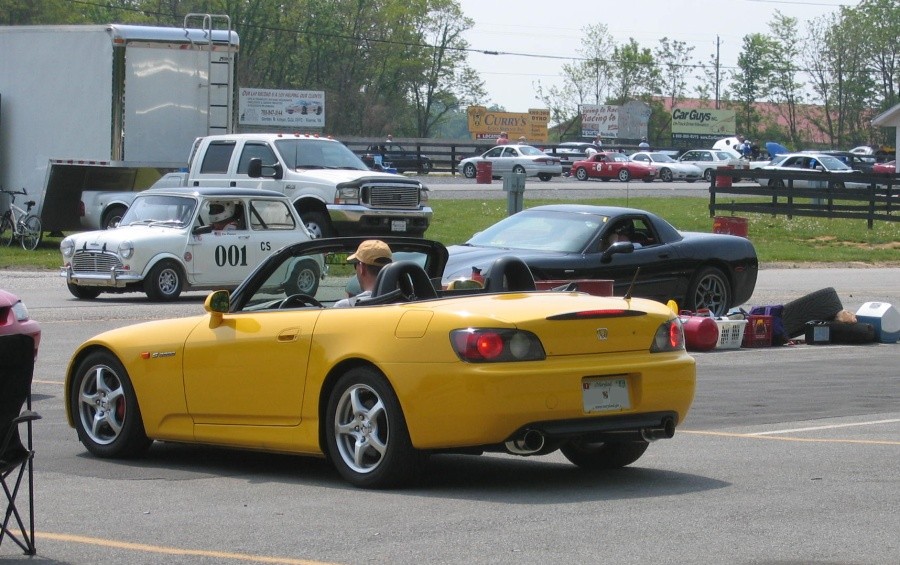
First Track Day
Many tracks in America now require an aftermarket roll bar for the S2000 but check with your local track and track day organizations to find out what they require. The stock S2000 roll hoops are so low that tracks are worried about their exposure to law suits from injured drivers and instructors. This change was forced on many tracks because volunteer instructors refused to ride in the S2000. The Hard Dog roll bar for the S2000 is a quality bar that's built to SCCA and NASA (National Auto Sport Association) standards. It's not an easy installation but well worth it once you get the S2000 on the track. If you're serious about tracking your S consider removing your center console so you can place the roll bar's harness bar at the right height for your racing harness shoulder straps.
If you're not ready to commit to a roll bar and can't find an organization that allows the stock roll hoops consider taking your S2000 to an autocross event. It's a great way to learn precise car control skills in a safe environment. I have instructed many experienced autocross students for their first track day and I'm always impressed how quickly they get up to speed. They already have the required car control skills and feel comfortable sliding the car around. Autocross is an inexpensive way to maximize what you get out of an expensive track day. Autocross parking lot cone courses are set up in hundreds of places across the U.S. every weekend. Start by visiting the SCCA website to see what's available near you.
The best way to sign up for your first track day is to find the website of your nearest race track and search their schedule or calendar. Most race tracks have multiple clubs/organizations that run track days. Most car specific clubs like the Porsche Club of America or BMW CCA allow other car makes to run on track with them so feel free to give them a call.
My local racetrack is Summit Point Raceway. It's about an hour west of Washington D.C. and offers a very good first track day experience with their Friday At The Track (FATT) track days. To sign up for a FATT go to the Summit Point FATT Website, click on "Calendar" and find a date that isn't full for Novices. They are working on an online registration page but as of now you need to call BSR at (304) 725-6512 to register. Summit Point requires an after market roll bar in the S2000 on the main course. Summit Point's Shenandoah Circuit can be run with the stock roll hoops but be sure to ask the track day organizer if stock hoops are OK before signing up.
All you normally need to do to ready your S for your first track day is inspect your car and replace your brake fluid. Make sure your tires and brake pads are in good shape. If they aren't you may fail the track tech inspection and won't be allowed on the track. Keep in mind when examining the brake pads the inside pad is usually thinner than the outside pad. Your brakes will get hot on the track and if your brake fluid is old it will boil due to moisture in the system causing brake fade and a soft pedal. I recommend ATE Super Blue brake fluid (or ATE 200 Gold, same fluid but different color to make changes easier). ATE brake fluid is hard to find so you'll probably have to order it online. Most racing supply stores like OG Racing sell it.
Track Day Run Group Progression
Most track day organizations divide drivers into three categories: novice, intermediate and advanced. The instructors usually have a run group of their own too. The novice group normally requires an instructor in the right seat. Once a novice gets comfortable on the track and begins to build awareness and speed he'll get bumped up to the intermediate group. For Friday At The Track (FATT) events two instructors must sign you off to move you up to the next run group. Passing for Novice and Intermediate run groups is usually allowed only on the straights with a point-by by the driver of the overtaken car--that way there's no surprises during the pass.
Intermediate students are normally cleared for solo (no instructor required) after some time in this group. This group is usually quite a bit faster than the novices and you'll find fewer "trains" of cars on the track.
The advanced group is not required to run with an instructor but they can request one if they want some additional help (everyone can benefit from a little instruction). NASA's advanced group runs with open passing--you can pass any car anywhere on the track without a point-by.
Competitive time trials is a good next step in the track day progression. NASA allows completely open passing (no point-bys required) during their TT sessions. The TT group rolls out on track and it's run just like a race qualification session. The car with the fastest lap in its classification (TTC, TTB, etc.) wins the event. NASA requires you to run in their advanced group (or the equivalent) and take a check ride to run TT. Ask your NASA region's head TT guy to request a check ride. I very much enjoyed the step up to competitive track events and it made me a much better driver.
With a few years of track experience many students make the jump to instructor. The primary benefit of instruction is the cost savings. Instructors are usually compensated with free or heavily discounted track time. The instructor group is normally the fastest, most experienced and most enjoyable run group. Most organizations have a minimum experience requirement to qualify to attend their instructor clinic. You'll also learn a lot by riding around the track in the right seat. You'll see common mistakes, learn the track and ride with guys that are better/faster/smoother than you.
Wheel-to-wheel racing is the final step for the weekend warrior. You'll need a full roll cage, electrical cutoff switch, window net, right side net, racing harness, fire extinguisher and other equipment to qualify for a competition school. NASA normally requires progression to their advanced run group to qualify to attend their comp school but the SCCA will allow anyone with a race car to attend. You can rent a race car to test the waters before committing to racing but it isn't cheap and if you break it you bought it.
Later in 2007 - Roll Bar & R-Comps

Track Upgrades
After you get your first track day under your belt you should consider upgrading your brake pads. Hawk HP+ are good beginning track pads that can be run in the car on the street and track. As you pick up speed and begin to brake later and harder you'll need to move to racing pads such as Carbotech XP10 (front) and XP8 (rear). If your brake lines are more than 5 years old you should replace them with Kevlar or stainless steel lines. The stock S2000 brake lines are high quality rubber covered fiberglass but are known to fail when subjected to too many track days and extreme heat cycles. A brake line failure can be catastrophic. Brake cooling ducts are a worthwhile modification. Placing aluminum tape over your wheel's balance weights will keep them in place. High heat can melt the adhesive and you can end up with out of balance wheels.
The first suspension upgrade I recommend is a stiffer front sway bar. An adjustable sway bar like the Gendron Sway Bar will allow you to set it soft for street tires and stiffen it up when you start to use r-compound tires.
A track oriented alignment will pay big dividends with lower lap times. Have your shop set the maximum equal negative camber up front, usually around -1.7 and about 0.5 degrees more in the rear (-2.2). The rear camber of the S2000 can usually be set as high as -2.5. Here's my alignment how-to. To get more negative camber up front you'll need offset ball joints or adjustable ball joints.
Upgrading the shocks to stiffer sprung coil overs will allow you to lower the ride height and reduce body roll and oscillations. You can run r-compound tires with the stock shocks & springs but to get the most out of them you'll need to upgrade the shocks. If you have coil overs you should have your car corner balanced to equalize the weight on the tires to optimize handling. Here's how I corner balanced my S2000.
It's a good idea to have tow hooks on the front and rear of the car to make it easy for the tow truck to pull you out of the gravel traps. If you don't have them the tow dude will use whatever he can access to pull you out and get the track under green again. You can use the stock tow hook and purchase a second one for the other bumper. I'm running J's Racing hooks, but folding tow hooks are required by some race organizers.
R-compound tires will make a huge difference in your lap times. You'll be able to brake later, carry more speed in corners, and learn to slide the car at the proper slip angle for maximum traction. The increased grip afforded by r-compound tires will stress the brake system and cause oil pan slosh. You'll go through brake pads and rotors at a surprising rate. When purchasing r-compound tires consider getting some light weight 17 inch wheels. Seventeen inch seems to be the "sweet spot" of wheel size. Sixteen inch wheels have a too tall sidewall, and 18 inch r-compound tires are usually much more expensive than 17 inch. You usually have a better selection of sizes in 17 inch too.
I also recommend non-staggered wheels and tires. Most of us run 17x9 inch wheels all around with 255/40/17 tires. The extra tire up front will help cure the S2000s low speed push. You'll need to roll the fenders front and rear and relocate the rear fender tab an inch or so to the rear to keep it from rubbing the tire.
Your r-compound tires will benefit from offset or adjustable ball joints up front. With them installed you can add all the negative camber you need, up to -4 degrees. Here's a link to the ball joint installation how-to. If you drive your car on the street a lot you won't want to set -3 degrees of camber because the inside shoulder of your tires will wear out much faster than the rest of the tire. I also recommend adding brake ducts to cool the front brakes when running r-compound tires, here's the brake duct how-to.
A rear wing and front splitter will help the S2000's handling qualities by reducing high speed lift. Here's a how-to for installing the APR GTC-200 wing. After getting used to the wing I ran a time trial with the wing removed and I was 1.8 seconds per lap slower--the wing really makes the rear stick in high speed corners.
I can't recommend the APR splitter because it's too small and costs too much. I replaced mine with a home brew 3/8 inch plywood splitter that extended the full 5 inches allowed by the NASA TT rule limits. The 5 inch extension was excessive and caused too much aerodynamic drag and I was quite a bit faster with a splitter that extended 1.5 inches--the Honda Challenge maximum.
NASA requires you to run soft top down no matter the weather. They are afraid in a rollover the S2000's top tubes and rails might break away and become objects of impalement. After running with NASA top town for a while I sucked it up and added a hard top from Hard Top Guy. If you remove the soft top you'll lose about 30 pounds with the stock aluminum hard top in its place. The car is more aerodynamic with the hard top and the rear wing will get smoother air and be more effective.
Learning to heel-toe downshift will make you a smoother and faster driver. I had to modify the accelerator pedal so I could execute a proper heel-toe downshift.
I purposely haven't mentioned any engine upgrades because the stock S2000 engine is so well tuned from the factory. The first engine mod I'd recommend is a cold air intake. It won't add much power but it makes the car sound so much better at high rpm. You'll feel faster with an intake.
A great way to lighten the car by about 30 pounds and free up the exhaust flow is to cut off the stock exhaust where it splits to the two mufflers. Have your favorite exhaust shop weld up a straight through muffler and pipe (Jegs has some inexpensive mufflers and tips) or just use a straight pipe to the rear of the car. A straight pipe sounds great at high rpm with the stock catalytic converter and resonator in place but it does drone at 3000 rpm. If you want something nicer then spend some big bucks on a single exhaust cat-back.
A header is a low bang-for-buck mod but it can add a couple horsepower and drop a few pounds, especially when coupled with a test pipe (catalytic converter removed) and high performance exhaust. With a free flowing intake and exhaust a piggyback ECU controller can tune the air/fuel mixture for maximum power.
2008 Track Season With The Soft Top & Ready for Time Trials
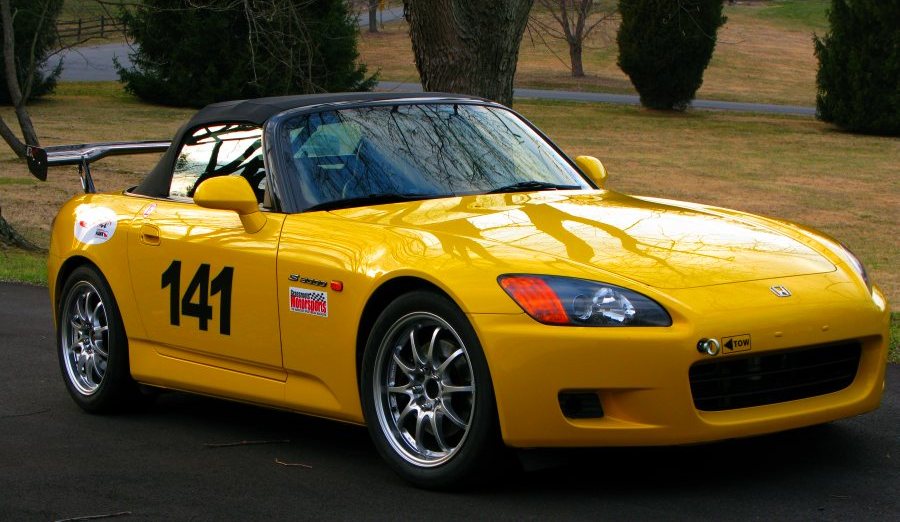
Reliability Upgrades
Keep in mind that a novice tracker will not stress the car nearly as much as an experienced and/or talented driver. The faster your lap times get the more stress the entire car will endure. The harder you push the car the more you have to do to keep it reliable.
The S2000's differential is the drive train's weak link. A regularly tracked S should have it's differential fluid changed at least annually. After draining the old diff fluid I like to pour a little fresh fluid into the diff with the drain plug still out to flush out as much dirty oil as possible before refilling. Be sure and use a good full synthetic fluid such as Mobile 1or Castrol diff fluid. The Service Manual says 75W-90 GL5 or GL6 fluid. Some racers prefer the warm weather only Redline Shock Proof differential oil. My personal favorite is Mobile 1 LS 75W-140 full synthetic gear lube. The S2000 does not require limited slip friction modifier be added to the diff fluid. Remember to remove the fill plug before the drain plug to insure you'll be able to refill it.
I normally don't recommend full synthetic engine oil for street driven cars. It's usually better to change the oil more frequently with non-synthetic oil than to stretch change intervals and use a much more expensive synthetic. However I do recommend a full synthetic oil for track S2000s. The extra stress of track duty justifies using the more expensive oil. S2000 oil temperatures get very high on the track so a high quality synthetic is recommended. Bearing tolerances are tight so a lighter oil like a 5W-30 works best. My personal favorite is Royal Purple XPR 5W-30 full synthetic racing oil. Another popular race-proven oil is Amsoil Dominator 5W-20 racing oil. The addition of an oil cooler should be considered for heavily tracked S2000s.
The transmission fluid isn't as critical as the diff fluid but should still be changed much more often in a heavily tracked S2000. Most people recommend using the standard Honda fluid but Redline MT-90 fluid is popular on track too.
2.0 Liter engines are known for cracking their valve retainers and allowing the valve to fall into the engine cylinder where it beats the head and cylinder walls into submission. Usually the damage is so severe a replacement engine is cheaper than repair. This happened to my 2001 S2000 with 45,000 miles and 35 track days on it. You can inspect the valve retainers by removing the valve cover but the retainers normally begin to crack from the inside out and the bottom up. You may be able to inspect the underside of the retainers with a flashlight and dental mirror. The 2.2 liter engines of the 2004 and up S2000s have upgraded retainers and their lower redline is less stressful to the valve train. Replacing your 2.0 liter engine's valve retainers with these upgraded retainers or more expensive and sexy (and lighter) titanium retainers is recommended for any car that sees more than light track duty. The more time your car sees high rpm operation the more important this upgrade. Consider it insurance against a $4500+ engine swap (and that's the price of a used engine).
Another upgrade for early 2.0 liter engines, prior to serial # F20C 1102 5386 (mid-year of MY2002), is the oil banjo bolt fix. In some countries the S2000 was recalled to replace the oil banjo bolts that squirt oil up into the cylinders for lubrication and cooling. This didn't happen in the U.S. so it's a worthwhile upgrade. The new bolts are about $40, but you must remove the cross brace that runs under the oil pan and the oil pan to replace the banjo bolts. Here's the s2ki how-to link. While you have the oil pan off it's a good idea to add an oil pan baffle.
The S2000's engine oil and coolant can get very hot on track--hot enough to damage the engine. Some drivers report oil temps approaching 300 degrees F and water temps in the 230's. A high efficiency, all aluminum radiator can help control engine temps. I installed an all aluminum radiator from Champion Cooling Systems. The core is much thicker than the stock radiator. In extreme heat such as Arizona you should consider a hood vent to extract hot air from the engine compartment.
The AP1 S2000 has a habit of spitting big blue oil clouds while on the track in extended right hand corners. An oil catch can will solve the problem and keep you from scaring the crap out of people behind you in fast sweepers. The stock engine has a PCV (positive crankcase ventilation) valve that allows the intake to suck blow-by gasses out of the valve cover. When the throttle butterfly closes (like during a shift) a great vacuum is created in the manifold. This vacuum sucks air/blow-by gasses/oil from the valve cover into the manifold. Oil can build up near the PCV valve and get sucked into the intake where it's burned and turned into blue smoke. By placing a catch can in this hose you can trap oil and keep it out of the intake. Here's the catch can how-to.
You might also want to verify the health of your engine by doing an engine compression check and/or a bleed down check. It's not a bad idea to adjust your valves more than called for in the owner's manual on a heavily tracked S2000. Here's how to adjust the valves.
S2000 track cars of all years will benefit from a baffled oil pan. Race compound tires and long sweeping corners allow enough lateral g-force to cause the oil in the oil pan to slosh to the side and allow oil starvation. Even short pressure drops during high power and rpm will cause engine damage. Baffled oil pans prevent the free movement of the oil in the oil pan to keep the oil pickup submerged in oil. You can purchase a ready made pan from several sources, or purchase just the baffle and have it welded into your oil pan. I picked up my baffle from eBay for $85 and spent $40 for TIG welding. Since both the oil pan and baffle are aluminum you must use the TIG welding process to secure the baffle.
Another oil system upgrade is the Accusump oil accumulator. It stores oil pressure and steps in to supply oil pressure during short duration fluctuations. Installation requires an adapter that goes between the engine and oil filter. Two lines come off the adapter to the Accusump. I haven't installed an Accusump but I am considering it as a future upgrade. Consider adding an oil cooler too, especially if you track your car in 100+ degree weather.
The one chassis reliability upgrade I recommend is to have the front upper suspension mounts re-welded to the body (see pic below). The mounts are spot welded in place and are known to crack and fail under the stress of r-compound tires. At the very least keep an eye on the mounts and inspect them every time you remove the front wheels. The AP1 mounts are weaker than the AP2 but failures have occurred in all model year S2000s. Make sure the mount-to-body seam is completely clean before welding as all the sealant mat must be removed. A stripper wheel on a grinder works well. If the mount has pulled away from the body it must be hammered back into place because you cannot weld an air gap.
Front Right Upper Arm Mount Pulling Away
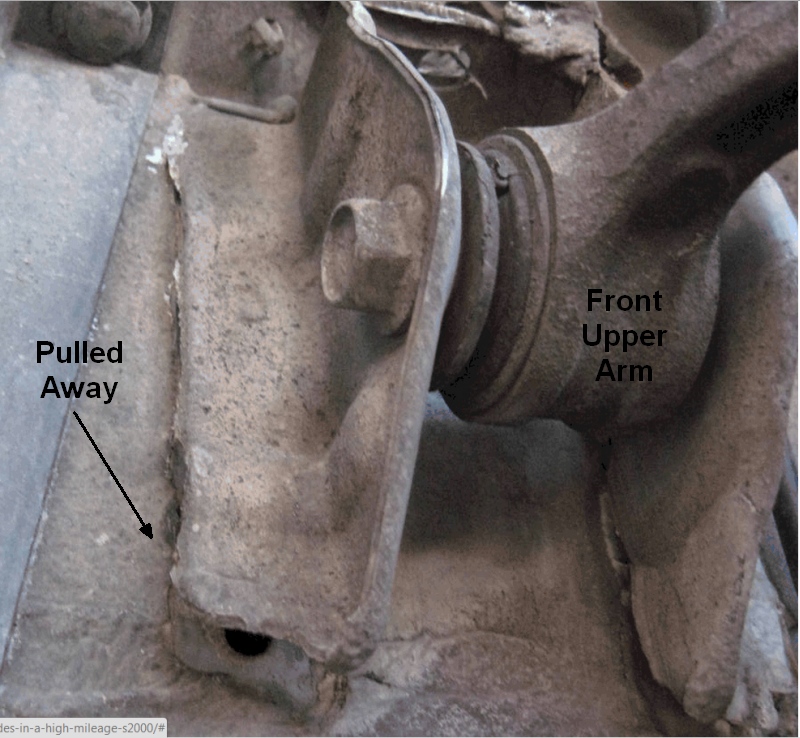
The front upper arm's rear edge of the rear support is usually first to fail.
Safety Upgrades
As mentioned earlier, a roll bar is now required by almost every track in the U.S. The Hard Dog roll bar for the S2000 is the standard bar in use today. It is a bolt in bar but requires the removal of all of the interior trim behind the seats. Removing the trim is an almost all day project for one person. The bar can be installed by one person but it definitely helps to have a friend help. The most difficult part of the install is the cutting of two slots in the wheel well for the front backing plates. If you want to re-install your interior trim it must be cut up to fit around the roll bar. It's a big project but worth it because the S2000 is such a great track car.
After you have a roll bar installed I recommend adding racing harnesses. You can run the stock three-point harnesses and racing harnesses at the same time. You can use clip on harness hardware so you can remove the harnesses when you're not at the track. You can run harnesses with the stock seats by running the crotch straps between the seat bottom and seat back. Just sit on the crotch strap and pull it up between your legs to buckle. I recommend running the inside shoulder strap through the hole in the stock headrest. You have to remove the headrest screen with four screws in the back of the seat. Run the outside shoulder strap between the end of the roll bar and the headrest. Running both harnesses through the headrest hole will pinch your neck and could be dangerous.
2009 Track Season & NASA Mid-Atlantic TTC Champ
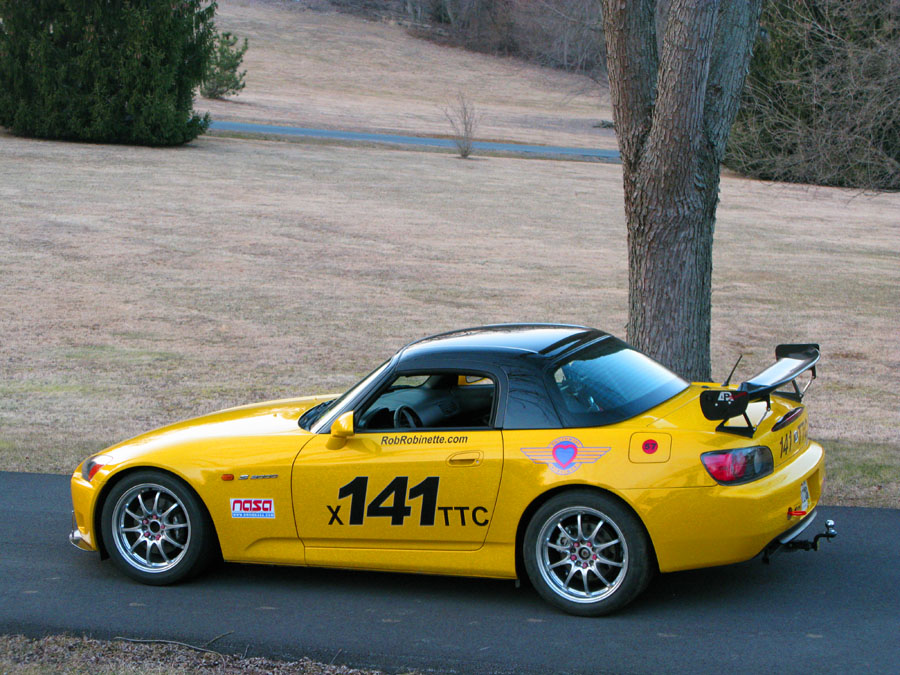
Racing seats offer more support during normal track driving and in the event of an accident. They also have slots for proper positioning of racing harnesses. Keep in mind that many track organizations require identical safety equipment for the driver and instructor so you may be forced to install two seats.
A head and neck restraint system (HANS Device) is a great investment. Your neck is the weak spot when running with a helmet and a good racing harness. A HANS device will help prevent whiplash type injuries to your neck, spine, and brain stem. I do a lot of instructing in cars with stock three-point harnesses so I chose the R3 which has a chest strap to provide support without a tight racing harness.
Late 2010 Track Season with Mongo Splitter & Roll Cage
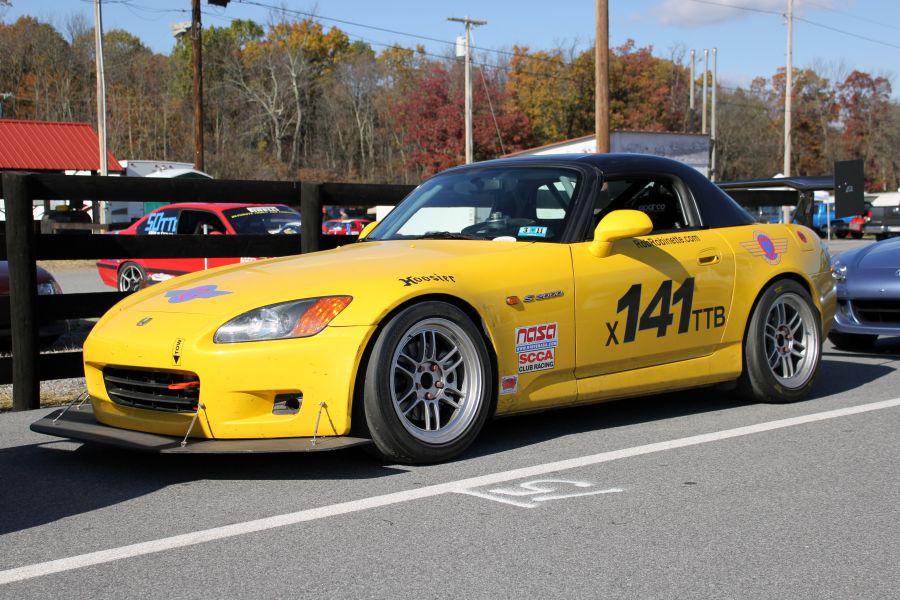
2011 In SCCA ITE and NASA PTB Racing Trim

The Roll Cage
You can run competitive time trials with NASA and the SCCA with just a roll bar, but if you want to race wheel-to-wheel you'll need a roll cage. I don't know if the Cusco Steel bolt-in roll cage would meet racing specs, but it's the only bolt-in cage I could find for the S2000. Another option is to have your roll bar extended by welding in a halo bar, front legs, and side bars to create a roll cage. Racers normally have a roll cage custom fabricated by a roll bar specialist for around $3500. Adding an SCCA approved roll cage is a point of no return for a track car because of all the surgery required to the dash and interior trim. It's very difficult to remove a welded-in roll cage and revert the car to stock form.
I broke down and had Piper Motorsports (near Dulles Airport) fabricate a roll cage. I went with the minimum size 1.5 inch tubing throughout to minimize the weight, especially high weight. To make the final push to wheel-to-wheel race car I added a window net, right side net and electrical kill-switch. You can read more about the race car transformation here.
October 2010 Prepping for the Roll Cage
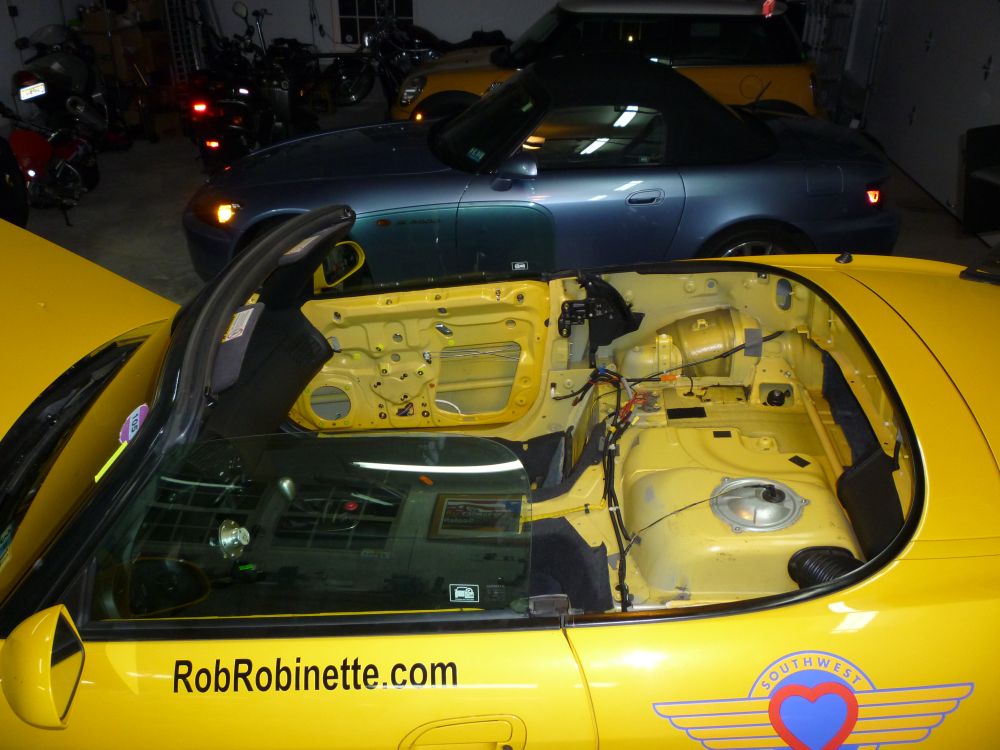

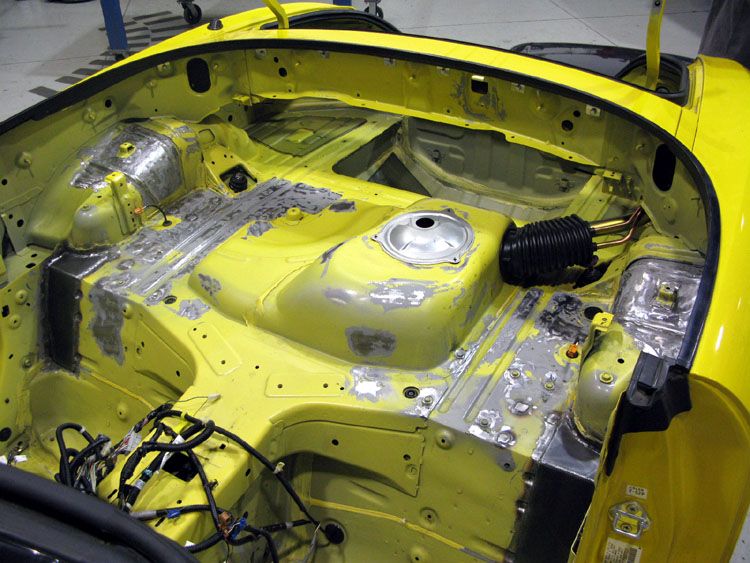
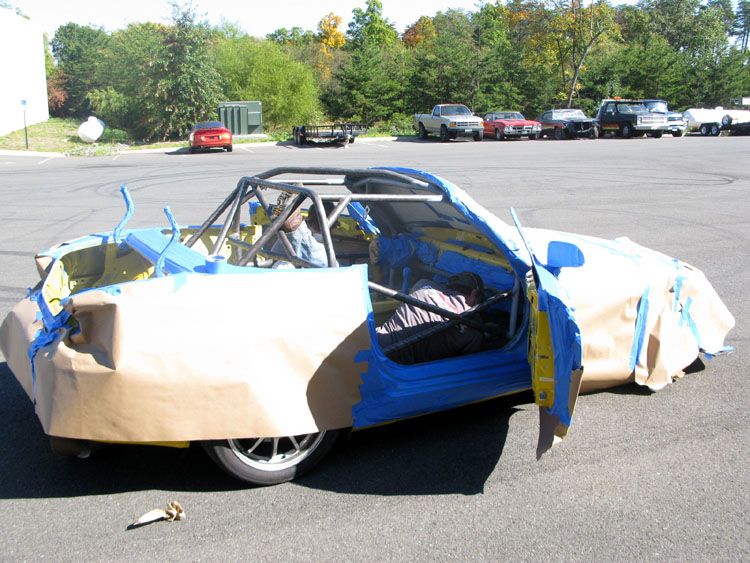
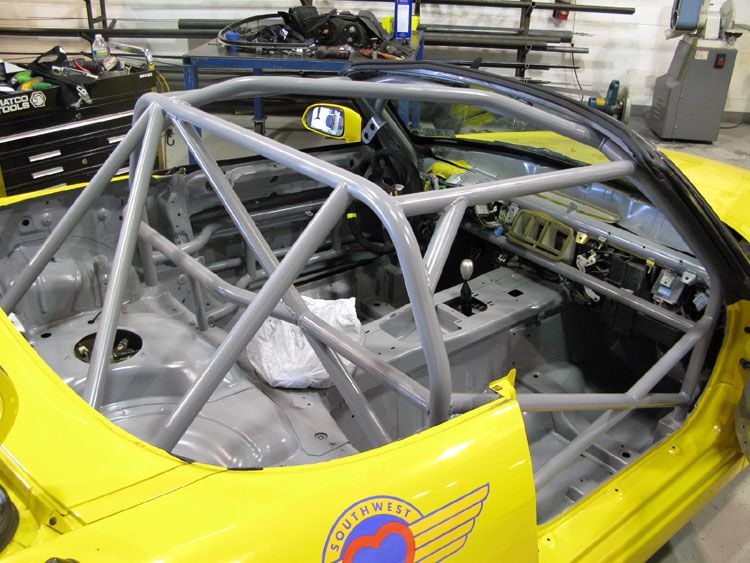
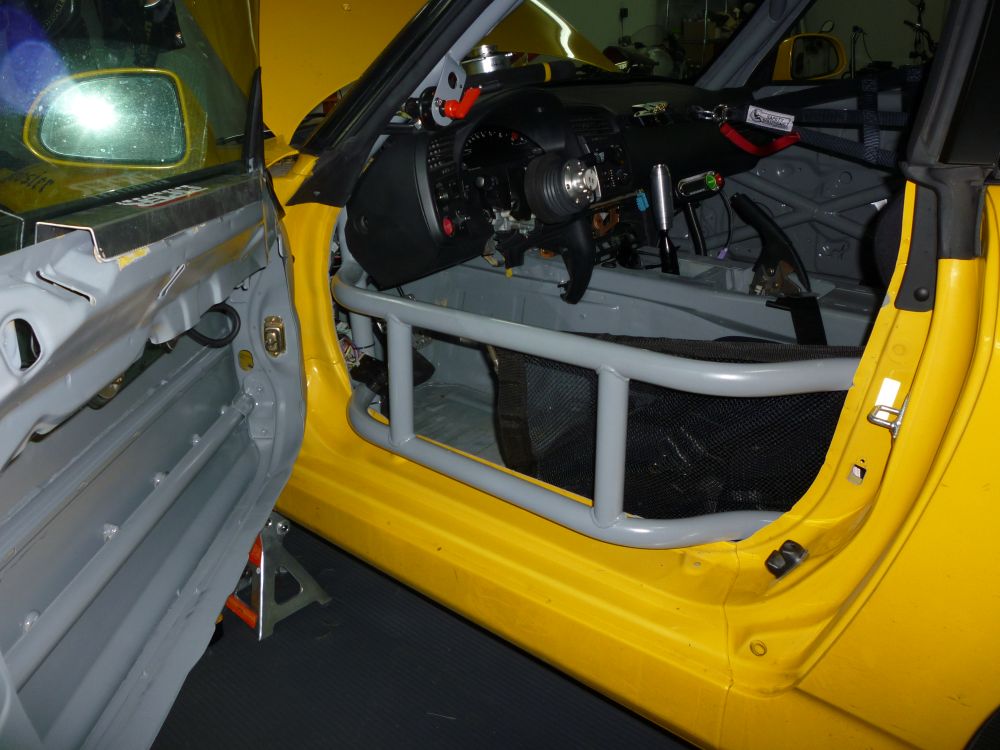
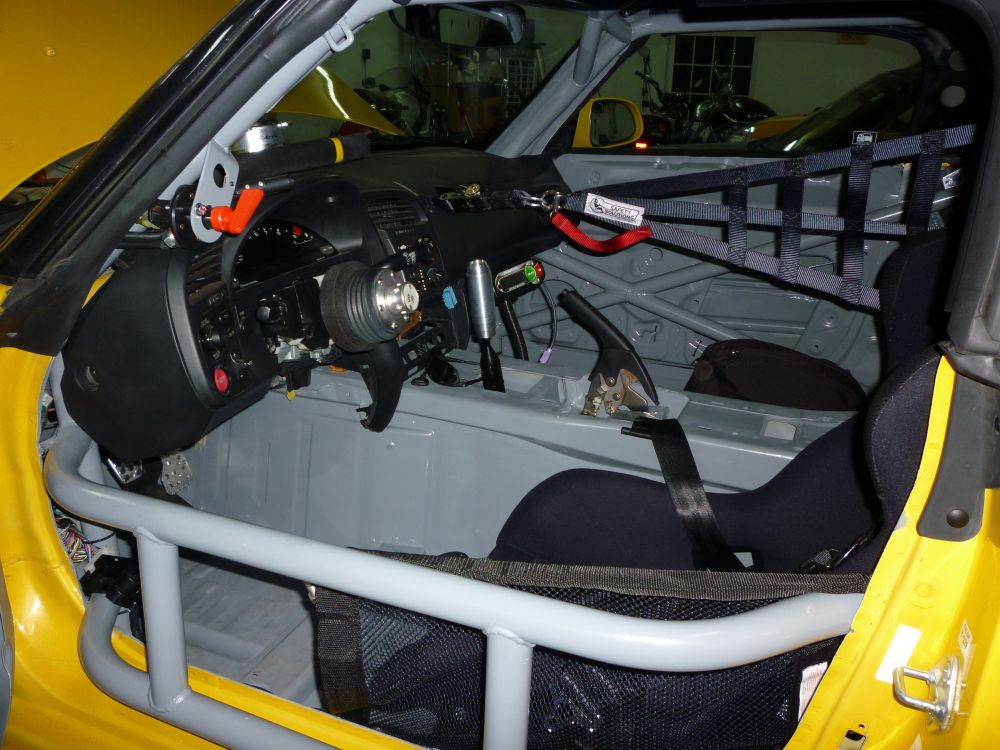
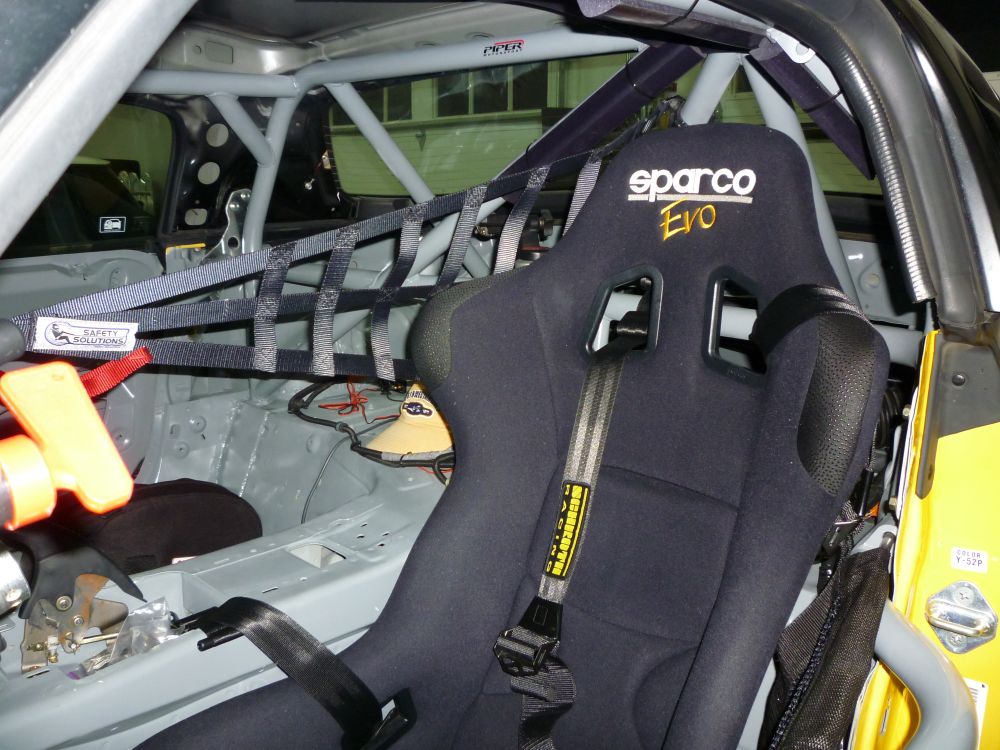


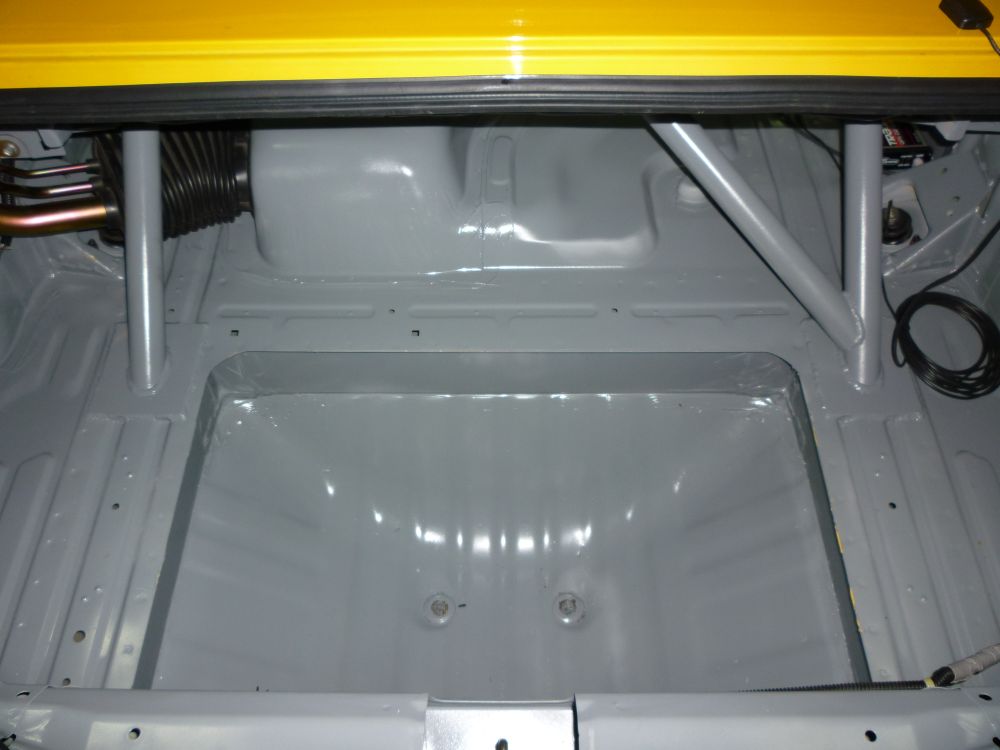
Recommended Sequence of Upgrades for a Track S2000
Roll bar (some tracks/organizers will allow the stock roll hoops)
Brake fluid to prevent brake fade
Aluminum tape over wheel balance weights (high brake temps can melt the weight adhesive)
Brake pads to deal with higher temperature
Kevlar or stainless steel brake lines
Banjo bolt upgrade for better oiling for early 2 liter engines
Racing harness for safety and more security
HANS device to protect your neck in an accident
Front sway bar upgrade to reduce body roll and increase stability
Track alignment to increase grip in corners
Valve retainer upgrade for 2 liter engines
Coil over shocks for stability and lowered ride height (corner balance them)
Racing seat(s) for safety and less sliding in the seat
Tow hooks to minimize towing damage
R-compound tires and lightweight 17 inch wheels for much more grip
Recommend 17x9 wheels all around (non-staggered) and 255/40/17 tires
Adjustable ball joints (or offset ball joints) up front for more negative camber for more cornering grip
Baffled oil pan to prevent oil starvation on long fast sweepers
Fire extinguisher
Cold air intake for a little more power but lots more sweet engine sound
Cat-back exhaust or cutoff to reduce weight and increase exhaust flow
Wing to reduce high speed lift and add stability in fast corners
Hard top to keep NASA happy, lose weight, and become more aerodynamic
Oil cooler and oil accumulator to keep engine oil cool and prevent pressure drops
Video camera and mount to review your performance and learn from your mistakes
Splitter to reduce high speed front end lift
Data acquisition to analyze your performance
Shift light to know when to shift when you can't hear your engine due to on track traffic
Don't forget more frequent differential, transmission and engine oil changes
Use this Summit Point Driver Debrief form and VIR Driver Debrief form to get the most from your track sessions.